Abstract
OBJECTIVE: To discover whether family physicians who go through residency training and The College of Family Physicians of Canada's (CFPC) certification process are more responsive than other physicians to woman abuse, whether they perceive and approach such abuse more appropriately, and whether they seek out more education on the subject. DESIGN: A national survey using a pretested 43-item mailed questionnaire to examine perceptions of and approaches to detection and management of woman abuse. SETTING: Canadian family and general practice. PARTICIPANTS: A cross-sectional sample of 1574 family physicians and general practitioners, of whom 963 (61%) volunteers responded. MAIN OUTCOME MEASURES: Demographic variables, perceptions of abuse, methods of diagnosing and managing woman abuse. RESULTS: Most respondents agreed they could not diagnose and treat woman abuse effectively, regardless of certification status. They indicated they were detecting only 33% of cases. Certificants of CFPC, in particular residency-trained certificants, were more likely to think that they should be diagnosing woman abuse than noncertificants; they were also more likely to help victims by referring them to specialists and other agencies. Certificants were also more likely to think they should be treating these patients themselves, and that they were not adequately trained to do so. Although most respondents thought they needed more education, certificants were more likely to know of relevant courses, to have attended such courses, and to have read books or articles on the topic. CONCLUSIONS: Being a certificant is not associated with perceived skills in diagnosing and treating woman abuse, but is associated with an increased awareness of the problem. Certificants know that education on woman abuse is available.
Full text
PDF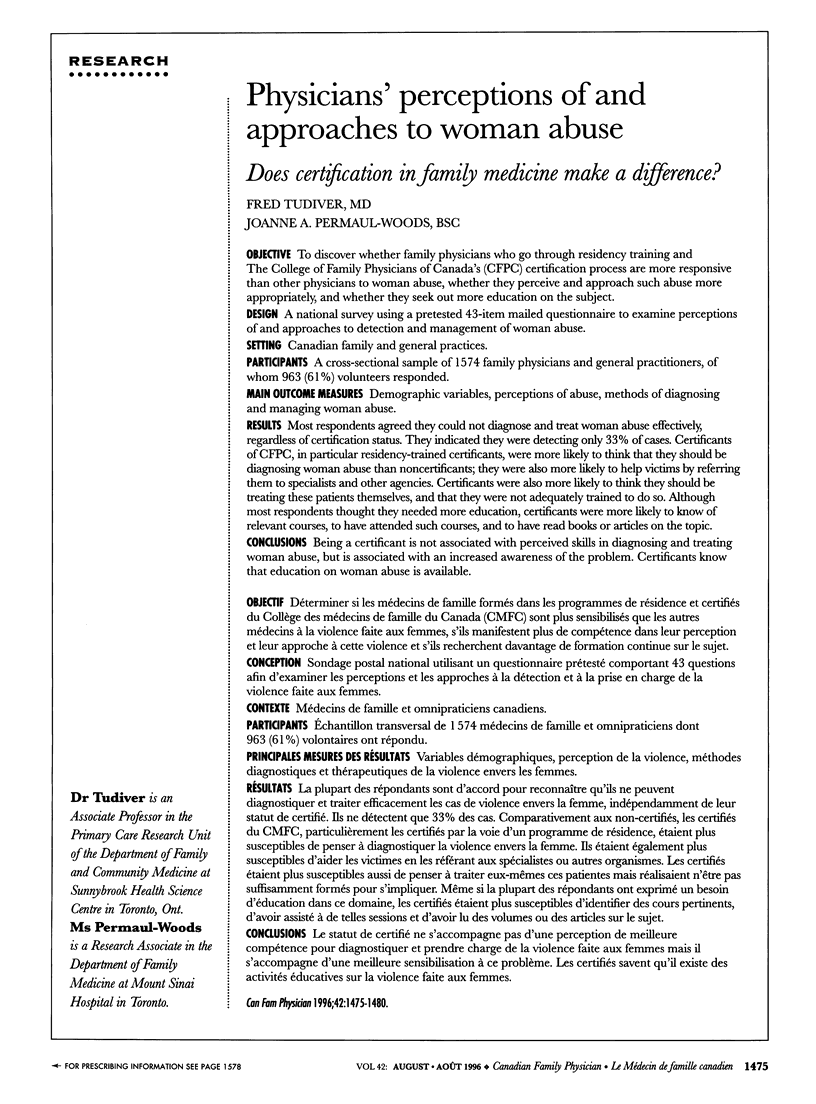
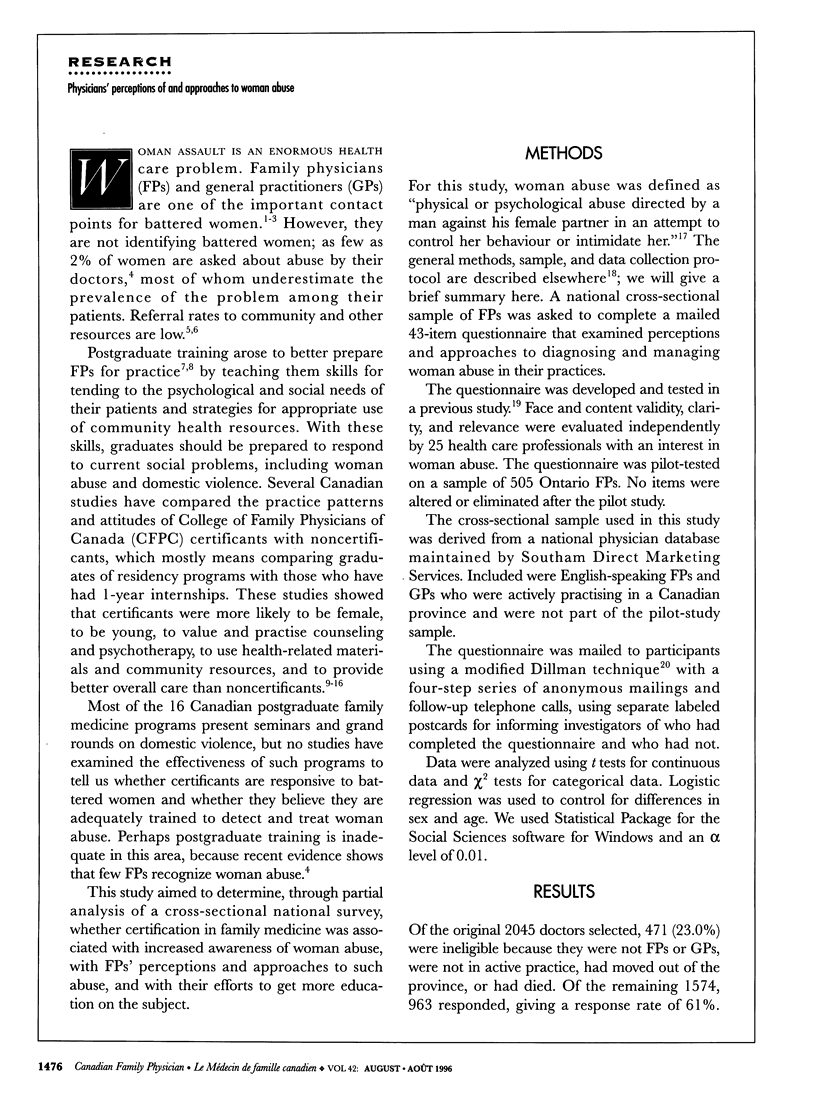
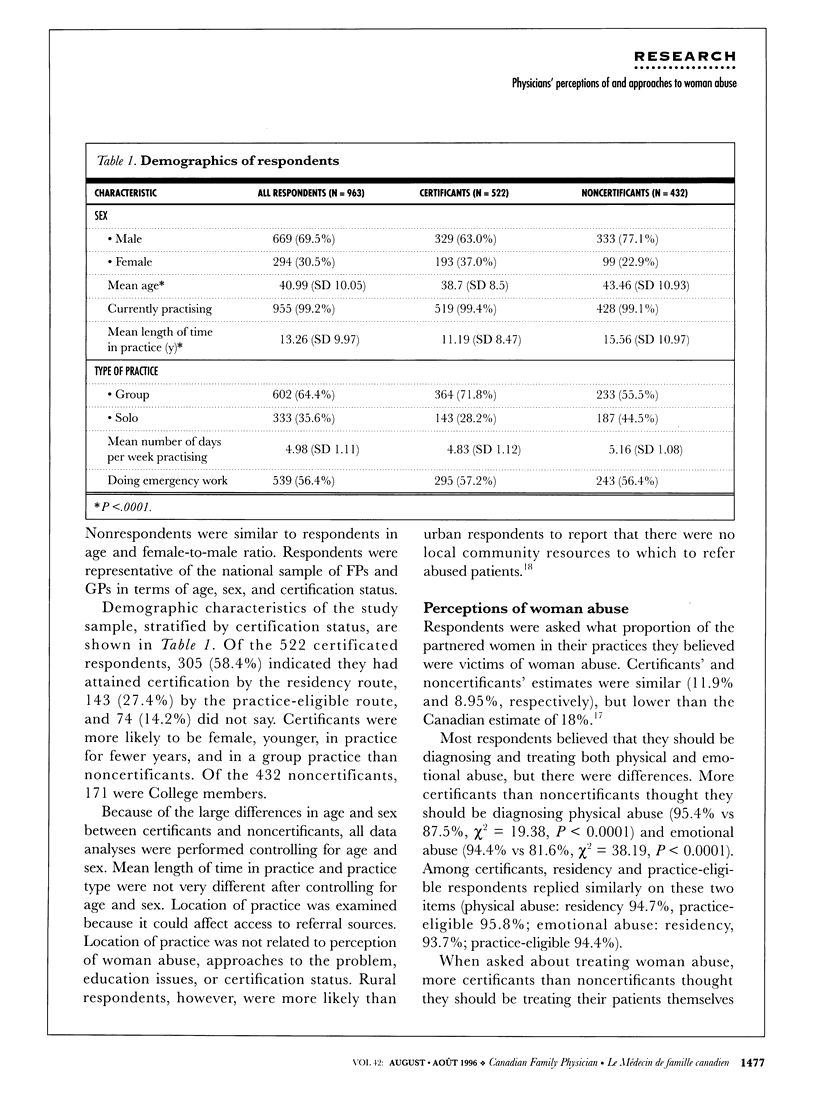
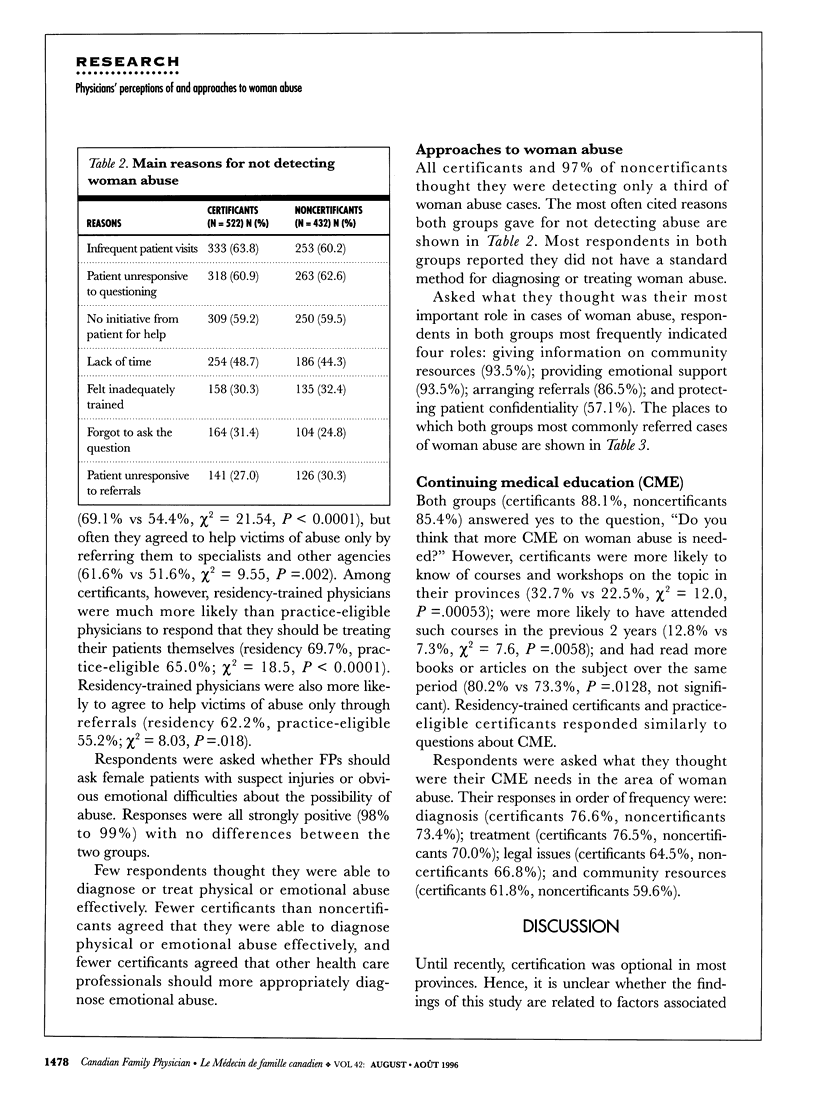
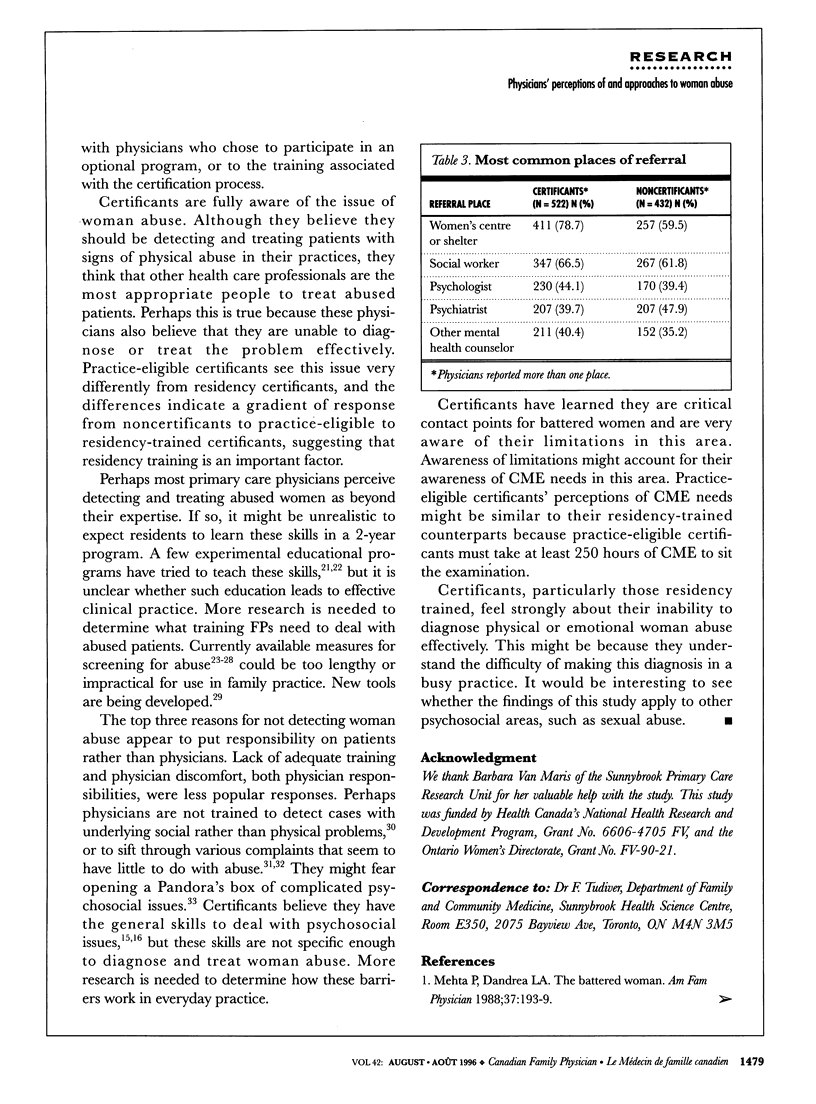
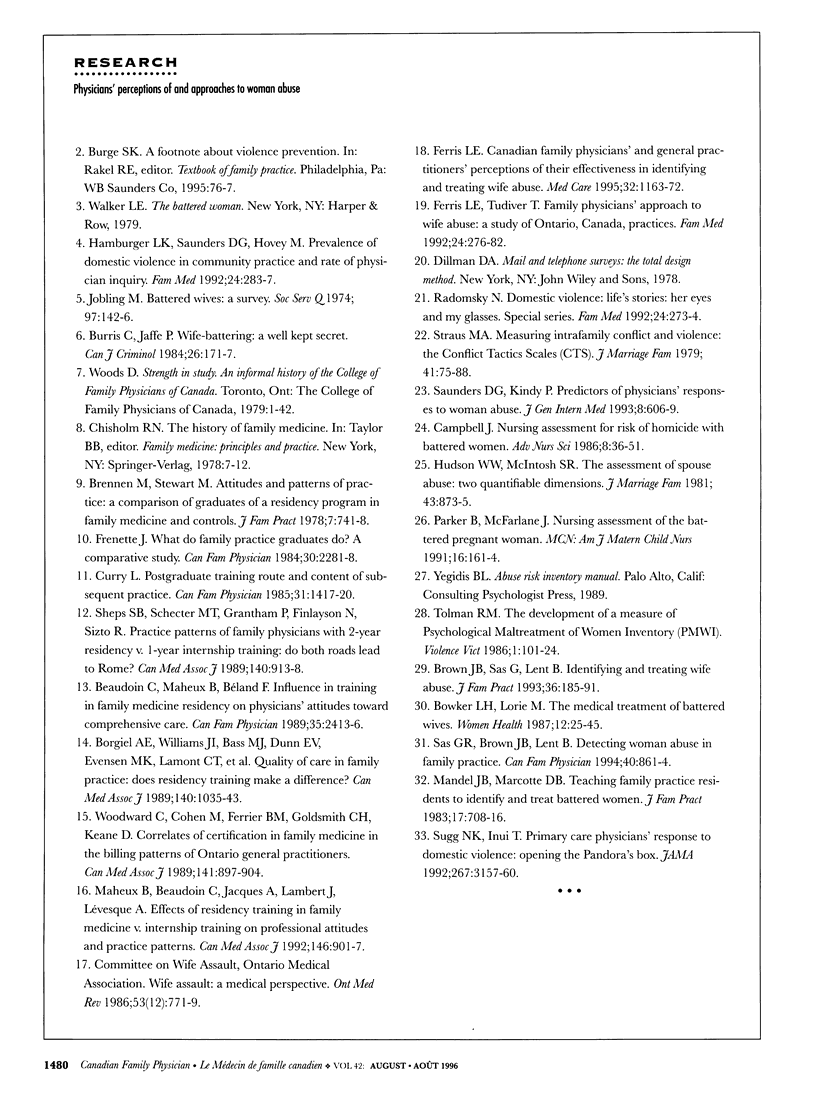
Selected References
These references are in PubMed. This may not be the complete list of references from this article.
- Borgiel A. E., Williams J. I., Bass M. J., Dunn E. V., Evensen M. K., Lamont C. T., MacDonald P. J., McCoy J. M., Spasoff R. A. Quality of care in family practice: does residency training make a difference? CMAJ. 1989 May 1;140(9):1035–1043. [PMC free article] [PubMed] [Google Scholar]
- Bowker L. H., Maurer L. The medical treatment of battered wives. Women Health. 1987;12(1):25–45. doi: 10.1300/J013v12n01_03. [DOI] [PubMed] [Google Scholar]
- Brennan M., Stewart M. Attitudes and patterns of practice: a comparison of graduates of a residency program in family medicine and controls. J Fam Pract. 1978 Oct;7(4):741–748. [PubMed] [Google Scholar]
- Brown J. B., Lent B., Sas G. Identifying and treating wife abuse. J Fam Pract. 1993 Feb;36(2):185–191. [PubMed] [Google Scholar]
- Campbell J. C. Nursing assessment for risk of homicide with battered women. ANS Adv Nurs Sci. 1986 Jul;8(4):36–51. doi: 10.1097/00012272-198607000-00006. [DOI] [PubMed] [Google Scholar]
- Ferris L. E. Canadian family physicians' and general practitioners' perceptions of their effectiveness in identifying and treating wife abuse. Med Care. 1994 Dec;32(12):1163–1172. doi: 10.1097/00005650-199412000-00001. [DOI] [PubMed] [Google Scholar]
- Ferris L. E., Tudiver F. Family physicians' approach to wife abuse: a study of Ontario, Canada, practices. Fam Med. 1992 May-Jun;24(4):276–282. [PubMed] [Google Scholar]
- Frenette J. What do family practice graduates do? A comparative study. Can Fam Physician. 1984 Nov;30:2281–2295. [PMC free article] [PubMed] [Google Scholar]
- Hamberger L. K., Saunders D. G., Hovey M. Prevalence of domestic violence in community practice and rate of physician inquiry. Fam Med. 1992 May-Jun;24(4):283–287. [PubMed] [Google Scholar]
- Maheux B., Beaudoin C., Jacques A., Lambert J., Lévesque A. Effects of residency training in family medicine v. internship training on professional attitudes and practice patterns. CMAJ. 1992 Mar 15;146(6):901–907. [PMC free article] [PubMed] [Google Scholar]
- Mandel J. B., Marcotte D. B. Teaching family practice residents to identify and treat battered women. J Fam Pract. 1983 Oct;17(4):708–passim. [PubMed] [Google Scholar]
- Mehta P., Dandrea L. A. The battered woman. Am Fam Physician. 1988 Jan;37(1):193–199. [PubMed] [Google Scholar]
- Parker B., McFarlane J. Identifying and helping battered pregnant women. MCN Am J Matern Child Nurs. 1991 May-Jun;16(3):161–164. doi: 10.1097/00005721-199105000-00013. [DOI] [PubMed] [Google Scholar]
- Radomsky N. A. Life's stories: her eyes and my glasses. Fam Med. 1992 May-Jun;24(4):273–274. [PubMed] [Google Scholar]
- Sas G. R., Brown J. B., Lent B. Detecting woman abuse in family practice. Can Fam Physician. 1994 May;40:861-4, 870-2. [PMC free article] [PubMed] [Google Scholar]
- Saunders D. G., Kindy P., Jr Predictors of physicians' responses to woman abuse: the role of gender, background, and brief training. J Gen Intern Med. 1993 Nov;8(11):606–609. doi: 10.1007/BF02599714. [DOI] [PubMed] [Google Scholar]
- Sheps S. B., Schechter M. T., Grantham P., Finlayson N., Sizto R. Practice patterns of family physicians with 2-year residency v. 1-year internship training: do both roads lead to Rome? CMAJ. 1989 Apr 15;140(8):913–918. [PMC free article] [PubMed] [Google Scholar]
- Sugg N. K., Inui T. Primary care physicians' response to domestic violence. Opening Pandora's box. JAMA. 1992 Jun 17;267(23):3157–3160. [PubMed] [Google Scholar]
- Woodward C. A., Cohen M., Ferrier B. M., Goldsmith C. H., Keane D. Correlates of certification in family medicine in the billing patterns of Ontario general practitioners. CMAJ. 1989 Nov 1;141(9):897–904. [PMC free article] [PubMed] [Google Scholar]


